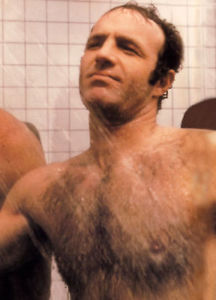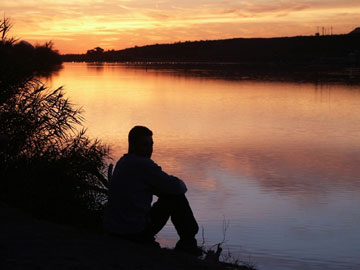
I recently watched an old movie starring James Caan. Quite a manly man, he was clearly the rough and tough sex symbol for the movie. In it there is a scene in which he has his shirt off. This is a hairy man, chest hair, back hair, all displayed proudly as he cleans his manly wounds in the mirror, the camera inviting us to admire him, to desire him. What struck me as I was watching was that I will never see this in movies or TV now – body hair has become such a taboo, we just don’t see how a natural human body might look.
Whether you like body hair or not, I think it is important that we take a moment to acknowledge the path we are going down in censuring its existence out of our lives. An up and coming male actor now would have to wax his chest and back to even get an audition, much less a part. And a woman with any body hair at all – the horror! And what we see becomes more and more constrained to one version of the human body, an adapted, smooth, youthful image.
Body hair for humans is a sign that one had passed puberty and has the sexual maturity that implies. It protects our skin and genitals from the external environment. And it may collect scents that signal to our unconscious sexual desire and possibly even compatibility of a partner. Pubic hair for women can increase clitoral stimulation during intercourse as the light tugging on it spreads to the network of clitoral nerves under the surface of the skin.
Trends are one thing, they come and go and embrace variety and change from one generation to the next. But completely rewriting, or re-imaging, how humans look by erasing certain natural variations is something different. Already most children probably have no idea that women also grow hair on their legs and underarms; they just have never seen that represented. Before we surrender completely to a world in which hairless bodies are the only bodies we see or even imagine, we might want to remind ourselves that sexiness comes in all kinds of surprising packages. Viva la difference!

There is a word in the Yaghan language of Tierra Del Fuego – mamihlapinatapei. While I have no clue how to pronounce it; I really like this word, which means a look exchanged between two people who both desire to initiate something but both are unwilling to offer themselves. This may sound like a depressing thing, but I think we could stand to get more comfortable with the idea of mamihlapinatapei.
We Americans are not so great at longing. We are conditioned to focus on getting. But over the course of human history there has been a lot of longing, and there will always continue to be unrequited, unsatisfied longing. We can see this as failure, as a problem unsolved. Or we can see it as a part of the human experience and proof that the world is full and abundant – so full and abundant that we cannot HAVE it all.
There is a long literary tradition focused on long suffering yearning and unexpressed desire. I admit I found much of this irritating, too many high neck Victorian dresses, too much pining and martyrdom, too much repression. And I certainly don’t want us to return to hidden sexual drives, hidden bodies, or social structures that enforce separation and make so much loving impossible. But as I have gotten older, I have realized that there is something to learn from expressions of yearning, especially the type of yearning mamihlapinatapei speaks of – when one part of our self wants one thing and another part feels in conflict with that.
How many damaging sexual choices might be avoided if we grew up with an awareness of this concept? What if we were taught to expect moments of desire that we will not choose to act on? What if we actually enjoyed the tension of longing for something? What if the wordless exchange in a glance between two people that contained possibility but not action was considered a valuable, even beautiful, experience?
I want people to have full shameless sexual expression and satisfying sexual efficacy. I want people to get what they want. But I also want people to be so turned on by life and the world around them that they will experience some overflow, some sense of just taking it in without taking action. And I would like us to see that as potent, capable of building us up and filling us with energy of potential and private wonderings, rather than as a sign that life is passing us by. Life is here for you, with more than you can experience in one lifetime. And that is okay. Sometimes a passing look is creates a powerful memory of another version of passion manifest simply inside of you.

There is a word in the Yaghan language of Tierra Del Fuego – mamihlapinatapei. While I have no clue how to pronounce it; I really like this word, which means a look exchanged between two people who both desire to initiate something but both are unwilling to offer themselves. This may sound like a depressing thing, but I think we could stand to get more comfortable with the idea of mamihlapinatapei.
We Americans are not so great at longing. We are conditioned to focus on getting. But over the course of human history there has been a lot of longing, and there will always continue to be unrequited, unsatisfied longing. We can see this as failure, as a problem unsolved. Or we can see it as a part of the human experience and proof that the world is full and abundant – so full and abundant that we cannot HAVE it all.
There is a long literary tradition focused on long suffering yearning and unexpressed desire. I admit I found much of this irritating, too many high neck Victorian dresses, too much pining and martyrdom, too much repression. And I certainly don’t want us to return to hidden sexual drives, hidden bodies, or social structures that enforce separation and make so much loving impossible. But as I have gotten older, I have realized that there is something to learn from expressions of yearning, especially the type of yearning mamihlapinatapei speaks of – when one part of our self wants one thing and another part feels in conflict with that.
How many damaging sexual choices might be avoided if we grew up with an awareness of this concept? What if we were taught to expect moments of desire that we will not choose to act on? What if we actually enjoyed the tension of longing for something? What if the wordless exchange in a glance between two people that contained possibility but not action was considered a valuable, even beautiful, experience?
I want people to have full shameless sexual expression and satisfying sexual efficacy. I want people to get what they want. But I also want people to be so turned on by life and the world around them that they will experience some overflow, some sense of just taking it in without taking action. And I would like us to see that as potent, capable of building us up and filling us with energy of potential and private wonderings, rather than as a sign that life is passing us by. Life is here for you, with more than you can experience in one lifetime. And that is okay. Sometimes a passing look is creates a powerful memory of another version of passion manifest simply inside of you.

Most of us have approached our dating lives with an image of sexual chemistry and desire that works like spontaneous combustion. It just suddenly hits without warning or intention and burns hard and fast, without our even trying – and can go out just as quickly. Our adult relationships may be better served by seeing sexual chemistry as a bit more complex and alchemical than that. We may not be able to create sexual chemistry anywhere with anyone, but we can actively engage with elements that build a chemical reaction we are hoping for.
Think of it like building a fire. You can sit and wait for lightening to strike and get the fire going. But this is not a great plan. It makes more sense to bring components together that will create fire. The fire will be just as hot, but you do have to put some effort and care into it.
You need fuel for the fire to burn strong and steady – Think of this as your body and your health. Are you giving your body what it needs to feel desire? Are you getting sleep, good food, exercise that is energizing not depleting, are you handling your stress? Basically, is your body ready and available to act on sexual chemistry?
The fire needs oxygen to stay alive – This relates to giving actual time and space for sexuality. You will not feel desire and chemistry while you are running from one chore to the next. Expecting to feel a lot of sexual chemistry on demand while overbooked and overworked, when you haven’t spoken to your partner in person for 3 days, when your mind is somewhere else, is like expecting lightening to strike – within a 30 minute window that is convenient for you. You need to actively create space, breathing room so to speak, for sex in your life.
Tinder will help the fire catch quicker – These are things in your life that you know make you feel more sexual, more connected or drawn to your partner, and sexier in general. Craft reminders of sensual pleasure into your day. Touch your partner as you pass by them, whisper about what you might do later in their ear. Make a point to build these things into your life so that, when the time is right, the spark can quickly catch and turn into a flame.
The Spark – Yes, the mysterious element that causes the flame to burst forth. There are many things we do that smother our natural sexual sparks and there are things we can do to encourage them, but who we desire and why remains, in large part, a mystery. There are different kinds of chemistry and there are different kinds of sex and what we want and are drawn to can change over time. One person may cause trembling in your thighs, another may cause you to feel playful and teasing, another warm and giving. Why him? Why her? Enjoy finding out…
Blondes, Brunettes, Gingers. Bears, Twinks, Dykes, Femmes. Clean Cut, Thick, Skinny, BBW, MILFs, GILFs, Androgynous. Many of us find ourselves drawn sexually to a particular look in partners. Luckily human tastes vary greatly so truly everyone will have a few admirers. But still, the concept of a type can make people uncomfortable. Is it ok to have a type? What does desire consist of? When does a type become a fetish? What about love, can it overcome a type, should it?
It’s probably pretty uncommon for someone to really not have a type at all. If asked to imagine a fantasy partner most people will have some set of attributes that frequently come to mind. But many of us have also found ourselves attracted to someone that at first glance we might not have thought would draw us in and our desire patterns shifted to include this person, maybe the way they move, or smell, or the way we feel when we are with them. There are so many components to desire; it is rare that it can be defined clearly.
And how we become attracted to the people or characteristics we are attracted to is largely a mystery. There are elements that are innate to us, elements that may be based on early memories, partners who imprinted us with positive or negative feelings, tendencies to be attracted to difference or to the familiar, all kinds of factors. It may be important to ask ourselves about our types to clarify if they are based on stereotypes about character –which may largely turn out to not be true about individuals. If you are drawn to bad boys because you think they will show you a secret soft side or asian women because in your fantasies they are submissive, you are probably in for some frustration and some angry partners. The fantasies themselves are not a problem, so long as you are aware that real people in the real world may not play these fantasies out just the way you imagined it.
And what if you have a distinctive feature that some people are searching out sexually? Does that change the nature of how you think of their bond with you? For example, if you are visibly disabled, there are people who specifically are looking for disabled partners. Does this feel ok to you? How do you assess if someone is fetishing an element of your look or body? Would you feel differently if the person is looking specifically for someone with large breasts? Why or why not? I believe some of our concern about distinctive types that people may be drawn to is based in discrimination against variations to the “normal” sexual model. If a big beautiful woman wonders how anyone can be attracted to her because she believes she is not the right kind of sexy, then she will question partners who openly seek out women with large bodies.
But even if we have come to peace with our own characteristics that people see initially, not many people want to feel that their partner picked them strictly for a physical characteristic, especially for one they have no control over. And some of these attributes we may age out of or may change over the course of our life. So people looking for long-term partnerships may be worried that sexual desire will disappear with changes in the way they look. We want people to be strongly attracted to us sexually, to love our attributes, but we also want to be seen as unique. Some flexibility in our attraction patterns will probably serve us well. Fine tuning our ability to recognize our own signs of physical desire is important too and may allow us to be surprised about who or what turns us on. So many beautiful people out there, keep your eyes and mind open.